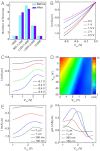High-frequency self-aligned graphene transistors with transferred gate stacks
- PMID: 22753503
- PMCID: PMC3406869
- DOI: 10.1073/pnas.1205696109
High-frequency self-aligned graphene transistors with transferred gate stacks
Abstract
Graphene has attracted enormous attention for radio-frequency transistor applications because of its exceptional high carrier mobility, high carrier saturation velocity, and large critical current density. Herein we report a new approach for the scalable fabrication of high-performance graphene transistors with transferred gate stacks. Specifically, arrays of gate stacks are first patterned on a sacrificial substrate, and then transferred onto arbitrary substrates with graphene on top. A self-aligned process, enabled by the unique structure of the transferred gate stacks, is then used to position precisely the source and drain electrodes with minimized access resistance or parasitic capacitance. This process has therefore enabled scalable fabrication of self-aligned graphene transistors with unprecedented performance including a record-high cutoff frequency up to 427 GHz. Our study defines a unique pathway to large-scale fabrication of high-performance graphene transistors, and holds significant potential for future application of graphene-based devices in ultra-high-frequency circuits.
Conflict of interest statement
The authors declare no conflict of interest.
Figures





References
-
- Novoselov KS, et al. Electric field effect in atomically thin carbon films. Science. 2004;306:666–669. - PubMed
-
- Novoselov KS, et al. Two-dimensional gas of massless Dirac fermions in graphene. Nature. 2005;438:197–200. - PubMed
-
- Zhang YB, Tan YW, Stormer HL, Kim P. Experimental observation of the quantum Hall effect and Berry’s phase in graphene. Nature. 2005;438:201–204. - PubMed
-
- Avouris P, Chen Z, Perebeinos V. Carbon-based electronics. Nat Nanotechnol. 2007;2:605–615. - PubMed
-
- Miao F, et al. Phase-coherent transport in graphene quantum billiards. Science. 2007;317:1530–1533. - PubMed
Publication types
MeSH terms
Substances
Grants and funding
LinkOut - more resources
Full Text Sources
Other Literature Sources

